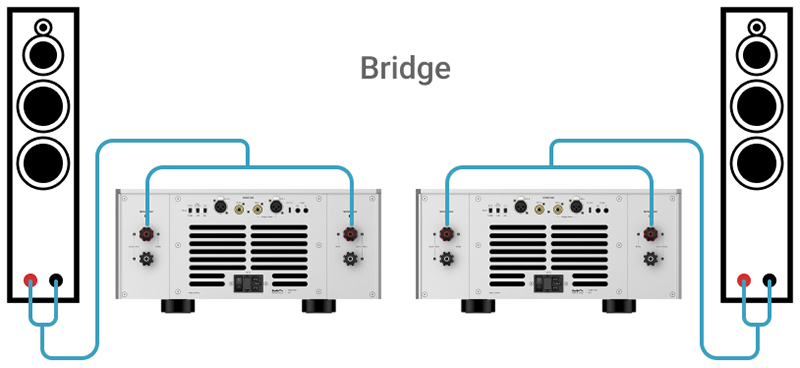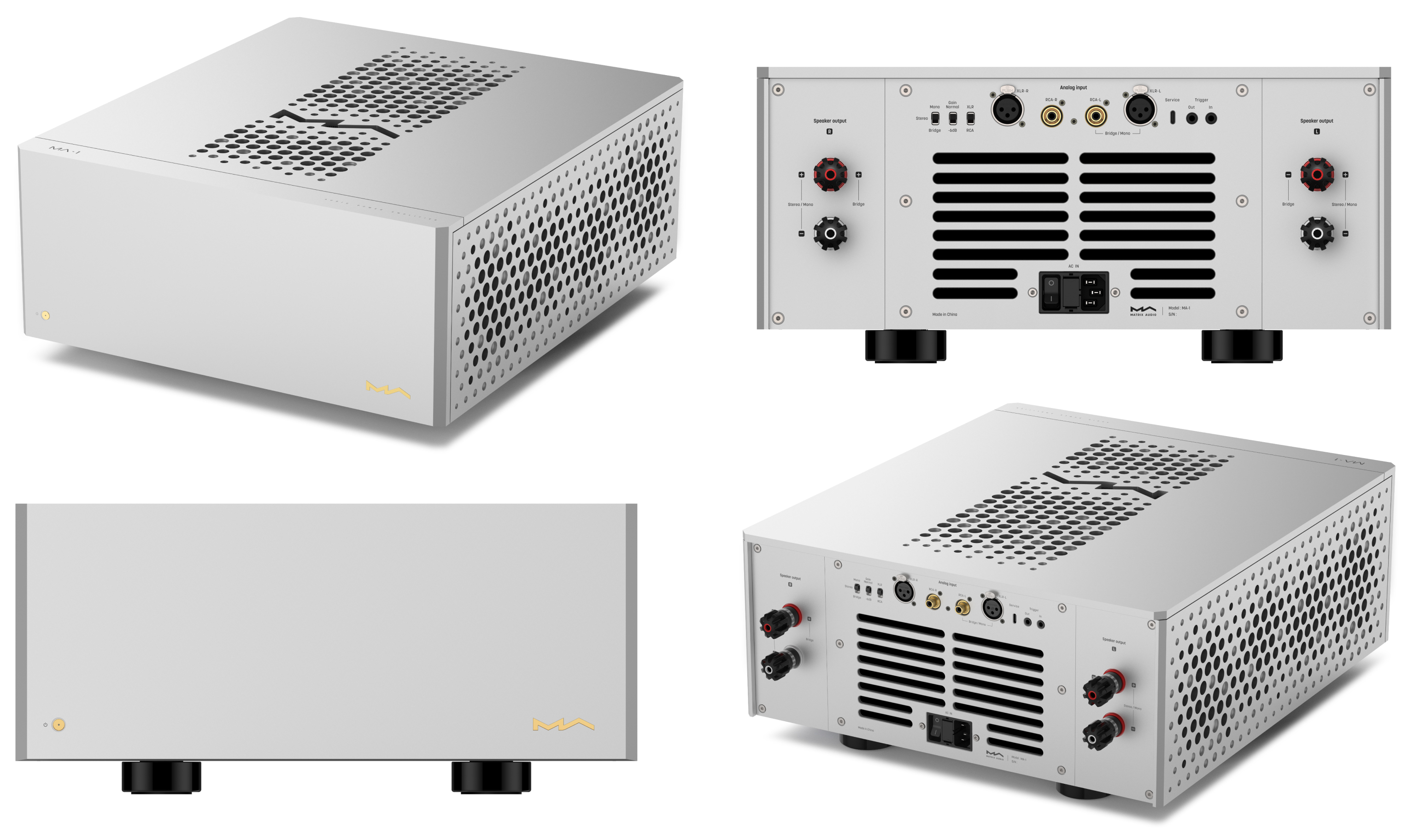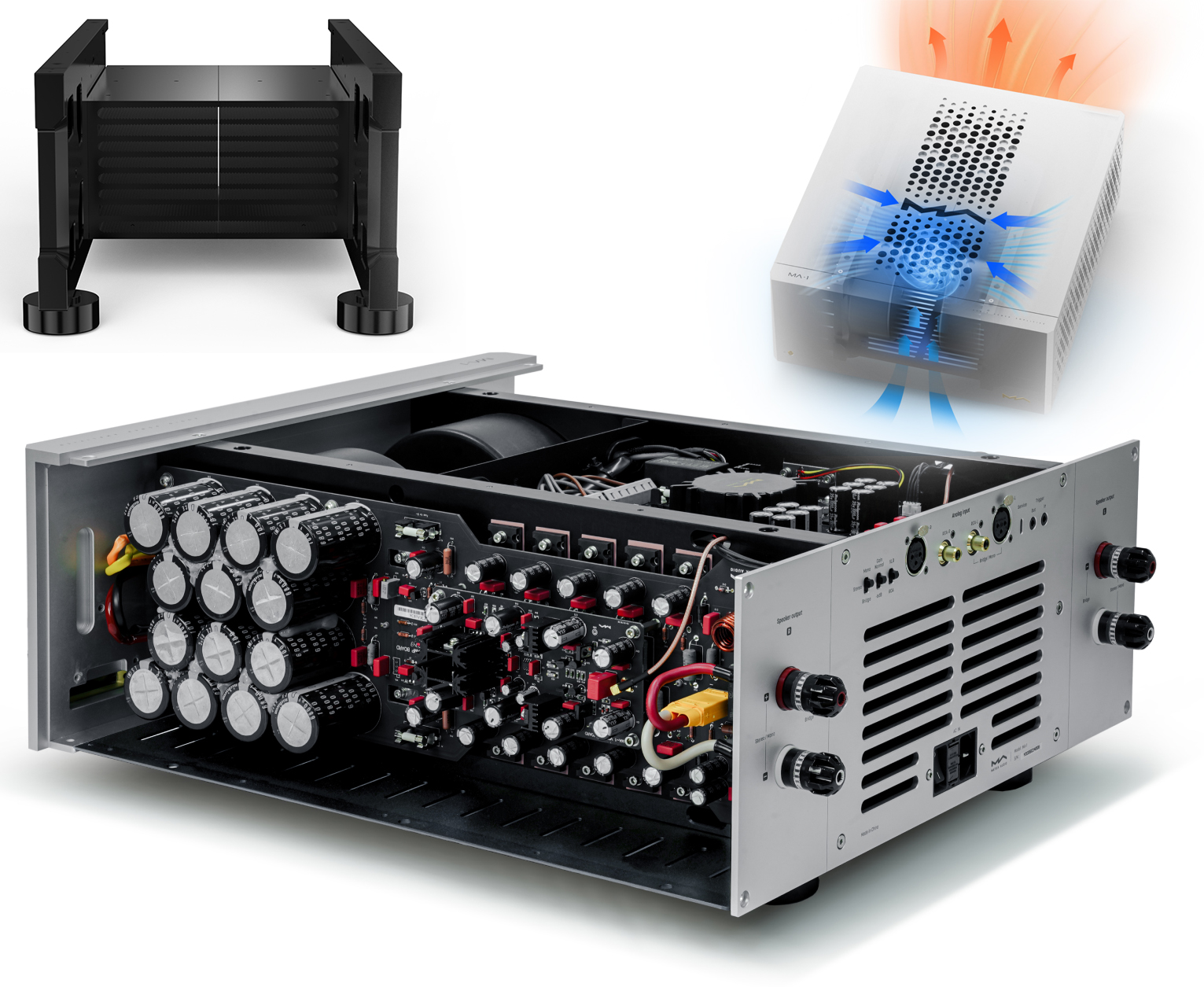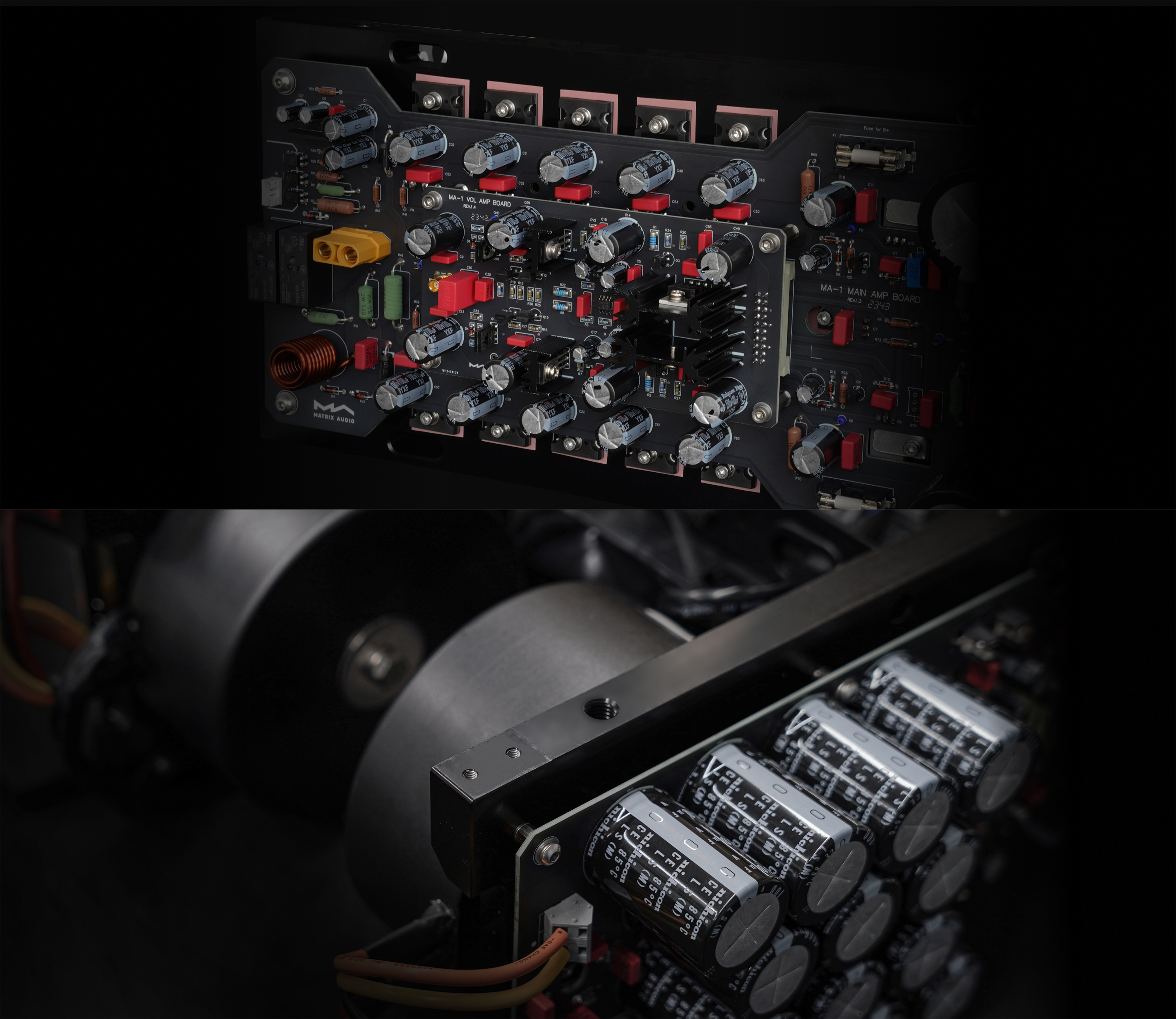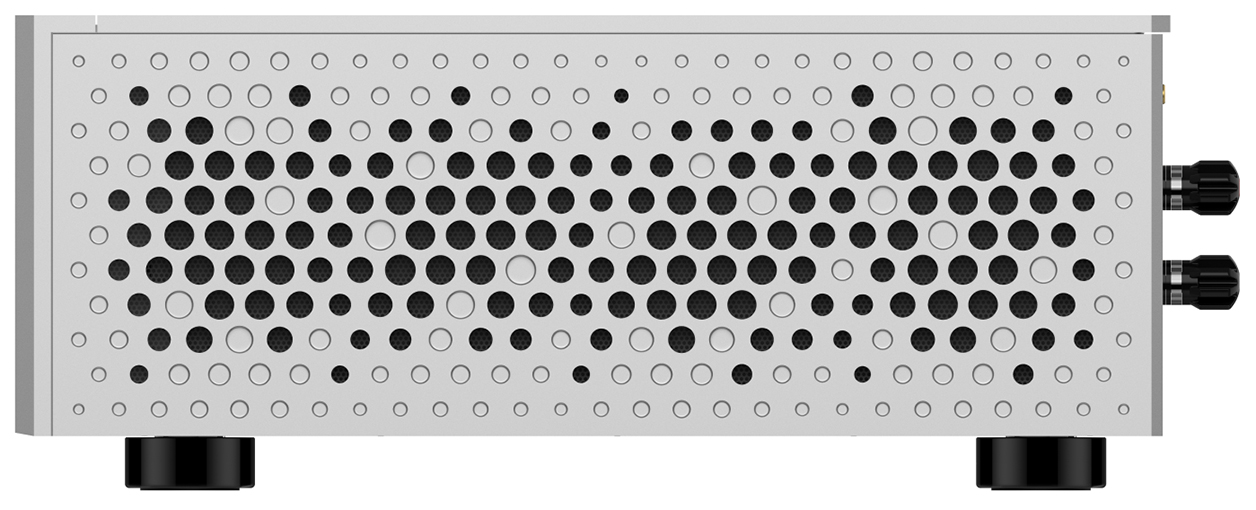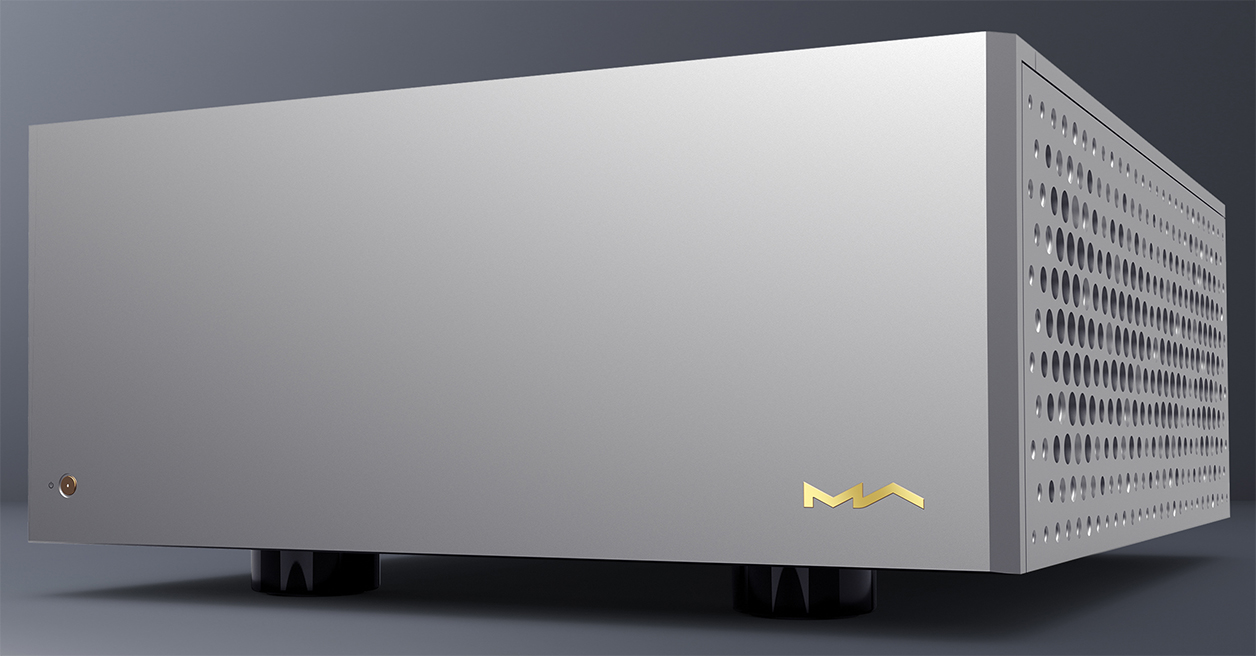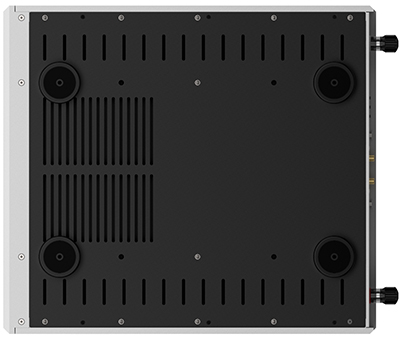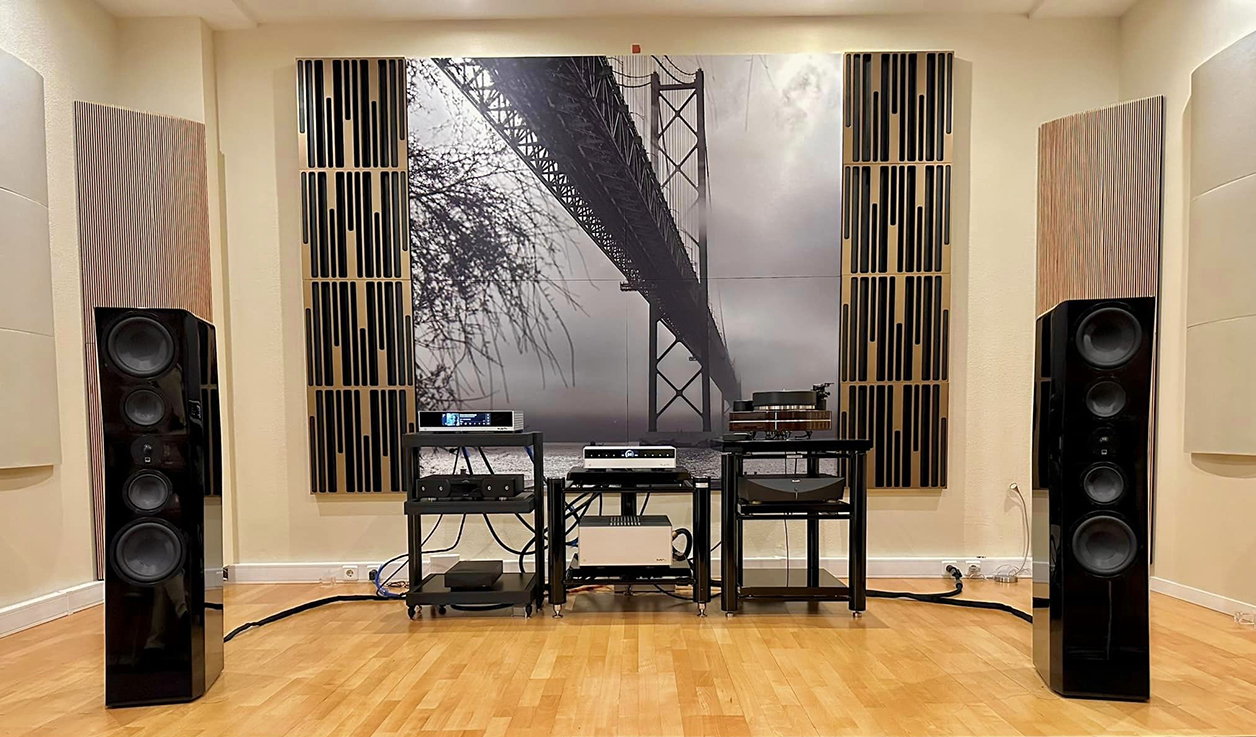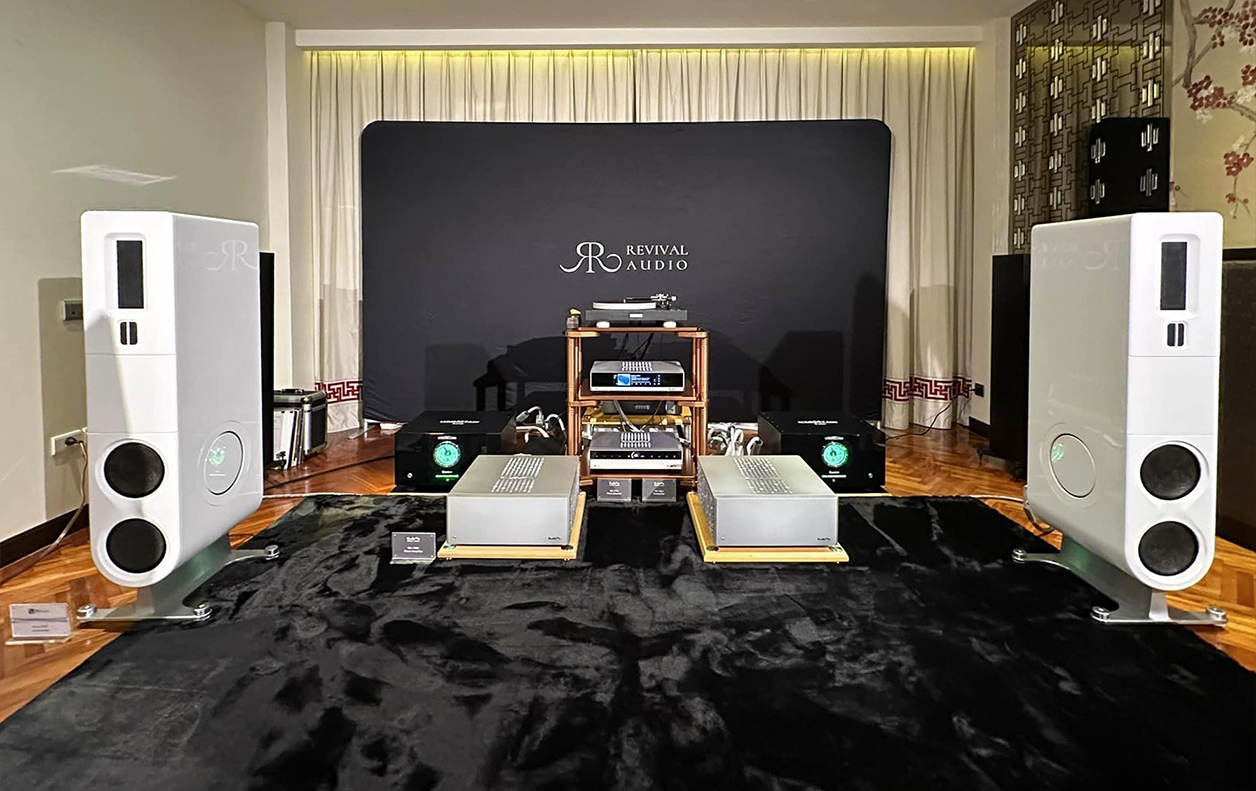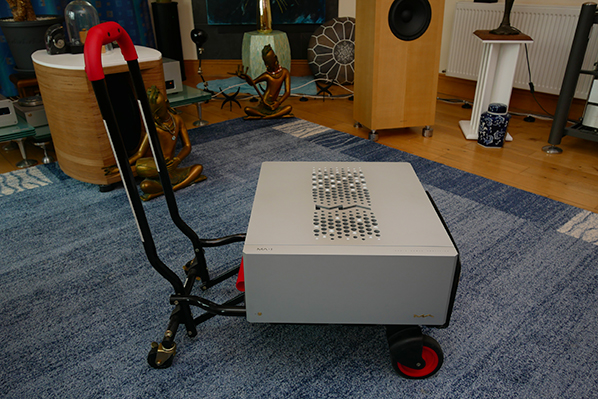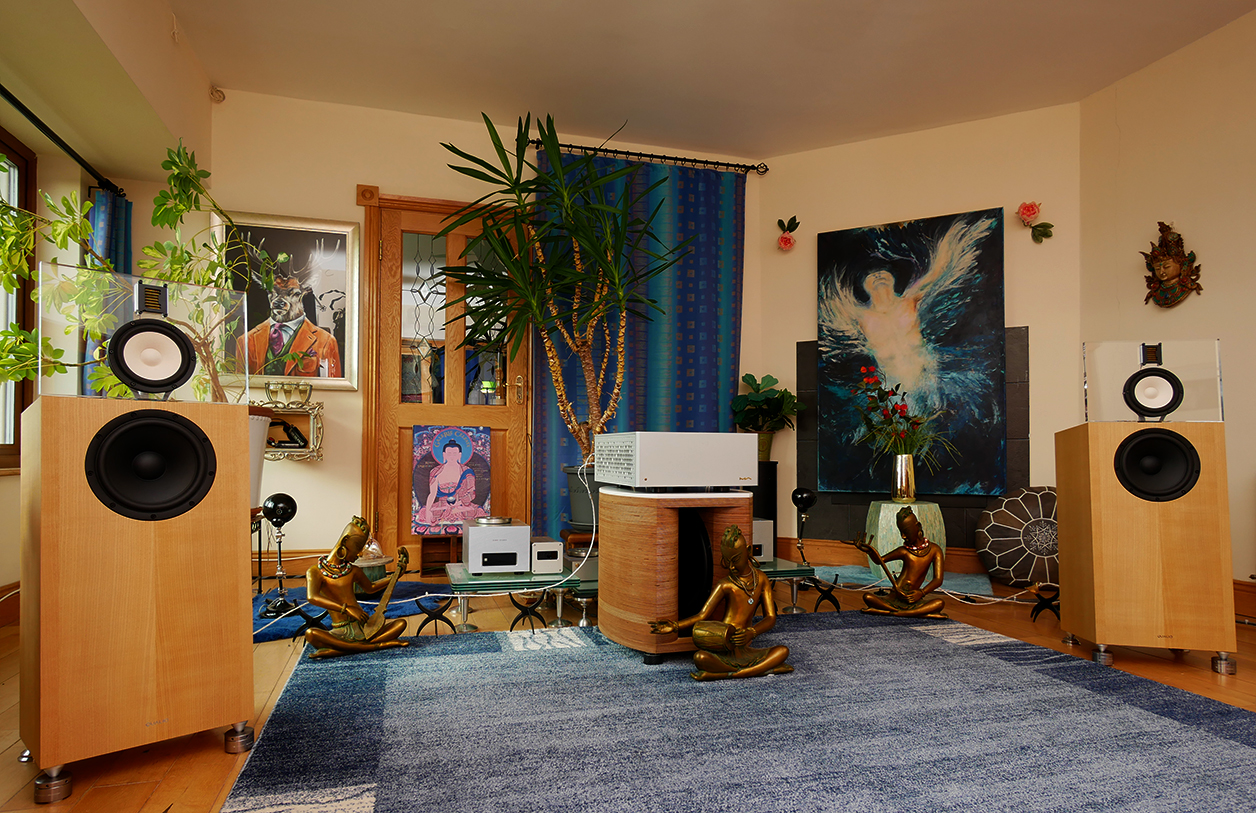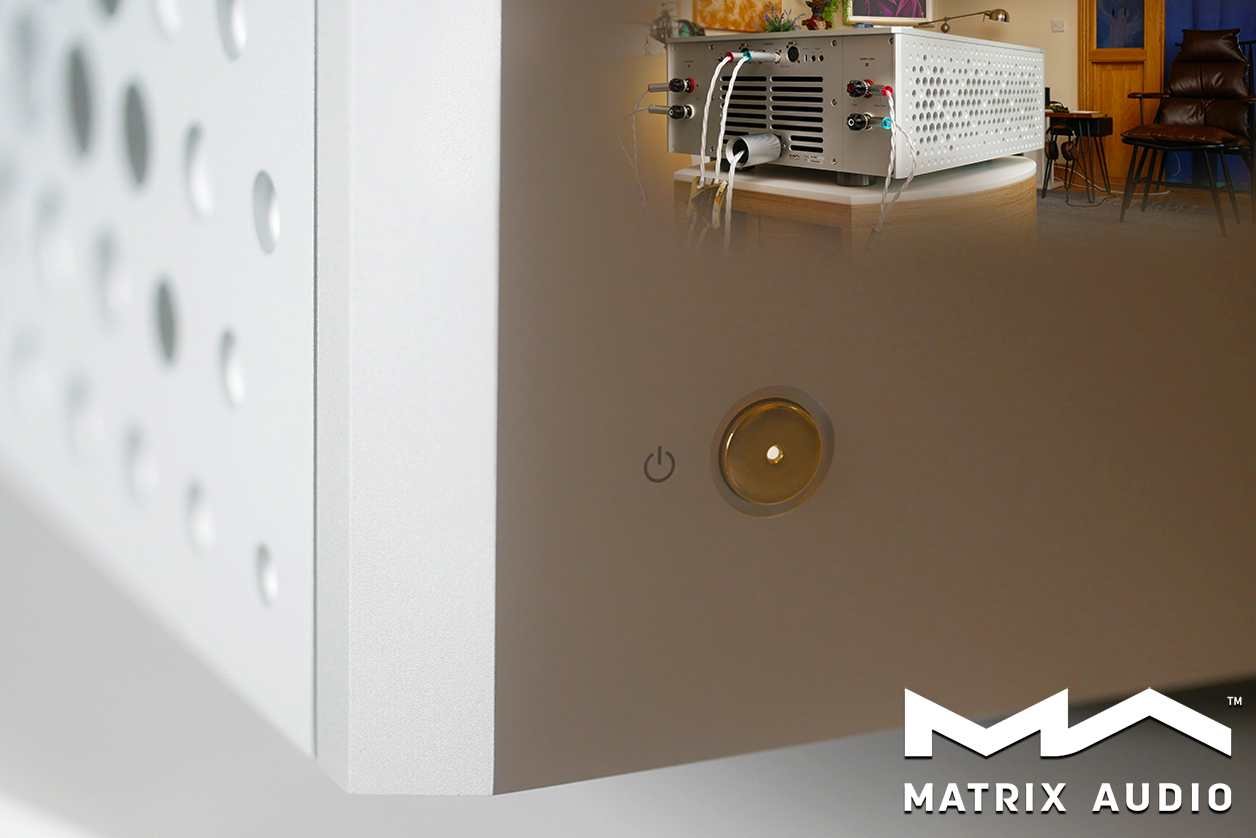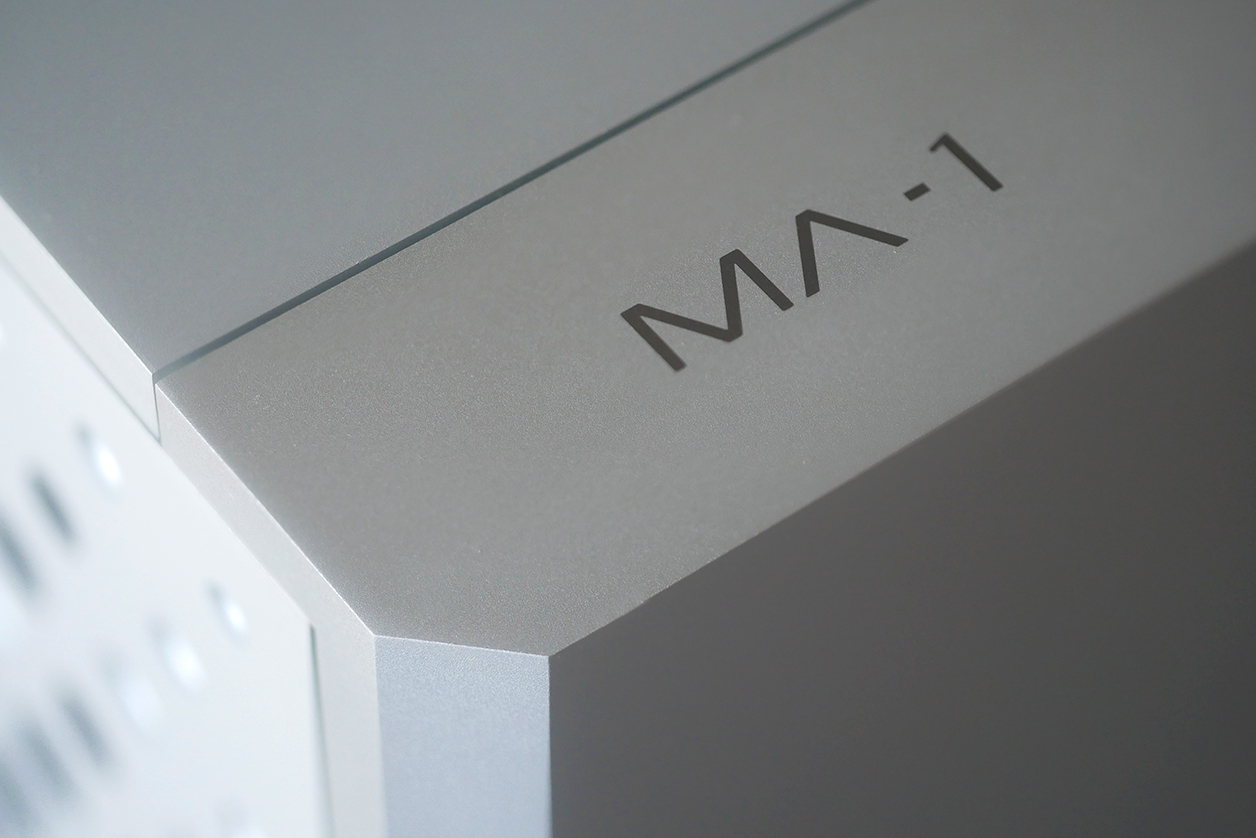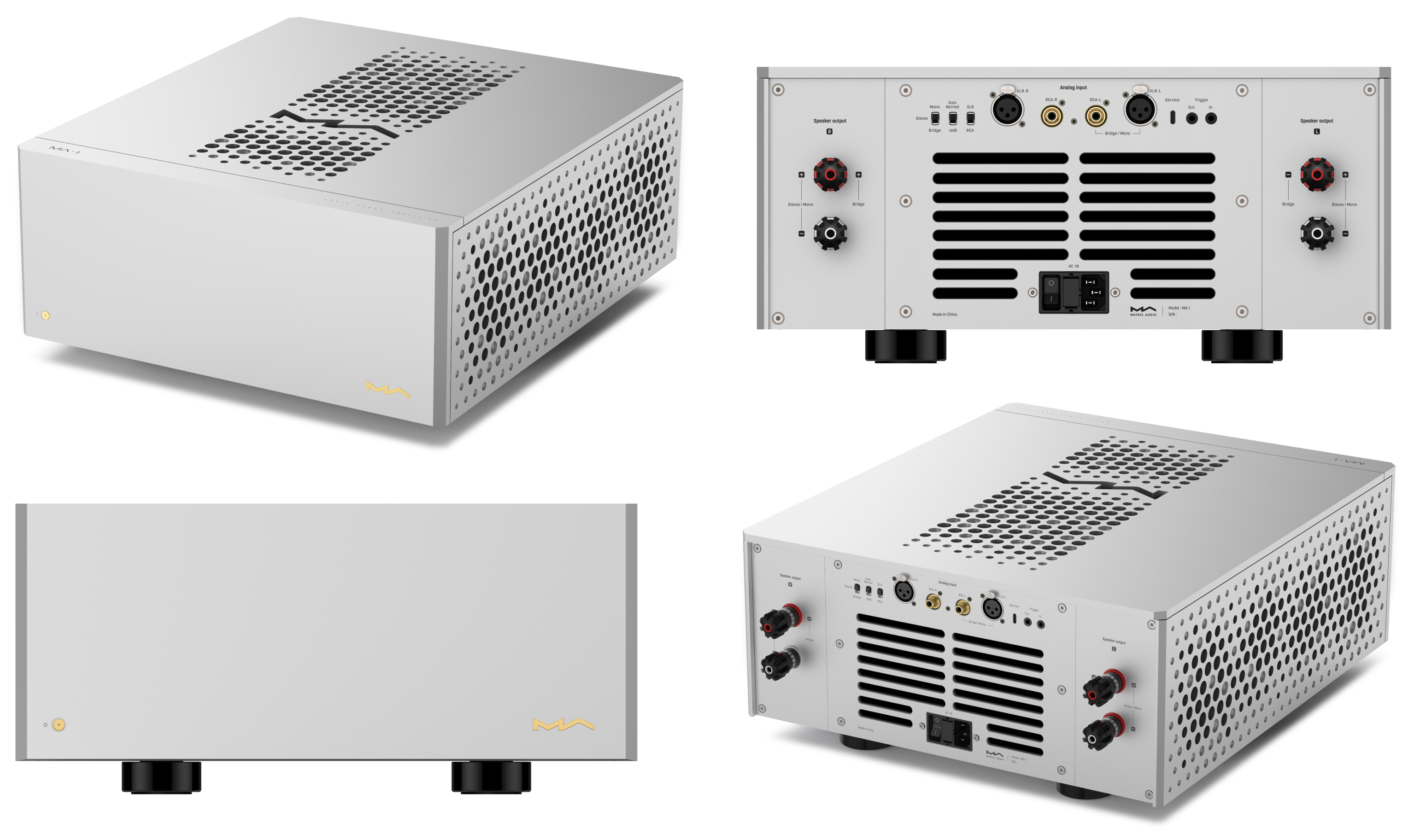A true high-end beast—— MA-1 Audio Power Amplifier
Main system:
Sources: Retina 5K 27" iMac (i5, 256GB SSD, 40GB RAM, Sonoma 14), 4TB external SSD with Thunderbolt 3, Audirvana Studio, Qobuz Sublime, Singxer SU-6 USB bridge, LHY Audio SW-8 & SW-6 switch, Laiv Audio Harmony;
Active filter: Lifesaver Audio Gradient Box 2;
Power amplifiers: Kinki Studio EX-B7 monos & Gold Note monos on subwoofer;
Headamp: Enleum AMP-23R;
Phones: Raal 1995 Immanis, HifiMan Susvara;
Loudspeakers: Qualio IQ [on loan]
Cables: Kinki Studio Earth, Furutech;
Power delivery: Vibex Granada/Alhambra on all source components, Vibex One 11R on amps, Furutech DPS-4.1 between wall and conditioners;
Equipment rack: Artesanía Audio Exoteryc double-wide 3-tier with optional glass shelves, Exoteryc amp stands;
Sundry accessories: Acoustic System resonators, LessLoss Firewall for loudspeakers, Furutech NCF Signal Boosters; Room: 6 x 8m with open door behind listening seat;
Room treatment: 2 x PSI Audio AVAA C214 active bass traps
2nd system:
Source: FiiO R7 into Soundaware D300Ref SD transport to Cen.Grand DSDAC 1.0 Deluxe;
Preamp/filter: Lifesaver Audio Gradient Box 2;
Amplifier: Kinki Studio EX-M7;
Headamp: Cen.Grand Silver Fox;
Loudspeakers: MonAcoustic SuperMon Mini + Dynaudio S18 sub;
Power delivery: Furutech GTO 2D NCF, Akiko Audio Corelli;
Equipment rack: Hifistay Mythology Transform X-Frame [on extended loan];
Sundry accessories: Audioquest Fog Lifters; Furutech NFC Clear Lines; Room: ~3.5 x 8m
Desktop system:
Source: HP Z230 work station Win10/64;
USB bridge: Singxer SU-2;
DAC: Sonnet Pasithea;
Headamp: Kinki Studio THR-1;
Speaker amp: Crayon CFA-1.2;
Speakers: Acelec Model One
Headphones: Final D-8000 & Sonorous X, Audeze LCD-XC, Raal-Requisite SR1a on Schiit Jotunheim RUpstairs headfi system: FiiO R7, COS Engineering D1, Cen.Grand Silver Fox;
Headphones: Raal 1995 Magna, Meze 109 Pro, Fiio FT32-channel video system: Source: Oppo BDP-105;
All-in-One: Gold Note IS-1000 Deluxe;
Loudspeakers: Zu Soul VI;
Subwoofer: Zu Submission;
Power delivery: Furutech eTP-8,
Room: ~6x4mReview component retail: €9'499
The Matrix Revolutions.
Today isn't about the 3rd instalment of the movie franchise. Today is about a virtual revolution and its third instalment. For more than a year now China's Kinki Studio have floated teasers of a flagship class AB monaural amp and demonstrated it at numerous Asian hifi shows even though their global website still makes no mention of it or the matching preamp.
Cen.Grand have their own 900-watt version called 9i-958 which seemingly has made little traction in the West yet. Now Matrix Audio bow the flagship M range above which includes a 250/450wpc stereo amp that bridges to 500/900 watt into 8/4Ω whilst being styled as sharp as Westminster Labs.
These Shaolin revolutions don't stop there. Laiv have their own GanFet monos of unknown power rating on the roadmap; Singxer just released their more modest 90/180W class AB monos. The era of budgetarian class D amps from China plus the constant flow of gear with glowing glass now includes very ambitious solid-state muscle amps that squarely aim at the best of the West.
On a whole, we who live there don't seem to have quite caught on yet. Will Matrix Audio's MA-1 manage to make their mark?
When I wrote these lines, no formal review agreement was inked. I'd introduced myself and been told that the person in charge would be in touch. I knew that the Bible of Asian Hifi Reviews—Audio Technique of Hong Kong—was working up a complete M Series system review. Clearly Matrix Audio were aiming straight for the top. I wasn't sure I'd even be invited. Regardless, their web presentation warranted a feature which would easily convert to our industry pages should a formal review not happen. So what are we looking at? A push/pull class AB circuit with ten OnSemi bipolar power transistors per side driven by a dual-mono 1'250VA power supply on ±80V rails. 14 x 6'800µF paralleled filter caps per channel add up to 190'000µF. Spreading the task over many smaller caps "lowers equivalent internal resistance for greater responsiveness to on-demand current swings". The internal H frame mounts the output modules to the outside, the power supply to the inside. The four footers bolt directly to this frame. Passive cooling augments by 7.4" fan activated when two heat sensors measure a value above the preset whilst MCU control adjusts the fan speed dynamically. Input impedance is 20/40kΩ on RCA/XLR respectively. Input sensitivity is 1.48Vrms in stereo mode, 1Vrms in bridged mode. Voltage gain is 30dB which can be reduced to 24dB via rear toggle. Frequency response extends to 160kHz -3dB. A-weighted S/NR in standard gain is 119dB, in high gain 123dB. Idle power draw is up to 350 watts, max power consumption 1'250 watts. Each amps weighs a considerable 42.4kg and packs into 43 x 20 x 52cm WxHxD.
As Gold Note have popularized with angled slashes of dissimilar lengths, the need for air circulation with high-power amp sans external heatsinks lends a good industrial designer an opportunity to get creative. Matrix embrace a pattern of circles of different diameter to create convection passages on the cheeks and top. Only the undercarriage and rear panel stick to classic slot vents.
The very simple front merely carries a stylish power switch in one corner, the 4th-gen company logo in the other. Timeless industrial design knows that less is more.
What's my takeaway from a read of their product page? I see comprehensive photos superior to their domestic competition. I see a site logo which proudly includes Chinese lettering. At time of writing, a global price remained unpublished. I didn't know where Matrix would position their best effort. Purely on specs and looks, I expected Westminster Labs pricing. After all, the Matrix portfolio is already multi-tiered. With that foundation laid, nobody could blame them if the M Series reached for the very stars.
Given how Kinki and Cen.Grand thus far played their equivalent cards simply had me wonder. Will Matrix likewise focus on conquering their domestic market first and let someone else do the heavy lifting beyond? By heavy lifting I mean the battle for—or rather, against—ongoing perception. Here hifi of Sino or Taiwanese origins is already perfectly 'legit' whilst it occupies the ±€5K mark. Questions (seem to) remain about what a Western buyer's response becomes once we play on the hot side of €10'000.
HifiMan's new Susvara Unveiled commands €8'000+. That's for an over-ear planar headphone. Numerous commentators with early hands-on feedback have remarked that subjective impressions on design/build don't quite measure up. It doesn't look much different than the €6K precursor which used gold traces whilst €2K more get us silver. Here the Matrix MA-1 photos tell me a different story. Add the published weight and I don't believe that cosmetics and build will have any trouble being accepted as a legitimate High-End effort which, were it from Europe or the US, would be expected to invoke a luxury tax. But has China, in 2024, managed to overcome all of the early reluctance which previously plagued Japan before Accuphase, Esoteric and Luxman became undeniably global High-End stalwarts? If so, will the M Range Matrix revolutions be the forerunner of this much-needed sea change?
Half an hour after publishing the prior page, I discovered the European ask including VAT on the Dutch Magna Hifi site: €9'499 just below what I called the hot side. Adding to the temps are the €10'999 MS-1 Music Streamer and €7'999 MP-1 Preamplifier to complete an M-Range system. We're on undeniably upscale turf. How will the market react? With outrage or open applause? At $2'798, Kinki's EX-M7 stereo amp does 225/310wpc and is what I use in my upstairs system. At $3'698/pr, their EX-B7 monos do 250/380W and work my main system. Already a Matrix MA-1 stereo amp outdoes my monos' 4Ω spec. We're clearly in a different league even before hitting bridged mono power at a stout €20K. The obvious question is, would our ears notice a higher league? If so, how many tiers higher?
"I read through your interesting report of the M series on your website. Really appreciate your hard work. It would be nice if you could review our amplifier. As you know, the MA-1 is a huge monster of more than 42kg and the price is not like earlier Matrix Audio products. We should consider how to move forward. From our existing dealer listing, can you suggest any good candidates who might help us do it?" Purely by proximity I picked Magna Hifi in Holland and Audiophonics in France as two dealers where 2-way shipping within the EU could be convenient. Whether they had inventory and were willing to loan it out was another matter. "Got your info. Will check if anyone is available with a unit." The ball had bounced. Benelux importer Michael Huigen picked it up. At his Reference Sounds, Matrix rub shoulders with Audio Research, Ayre, D'Agostino, Mark Levinson, Wilson Audio and Wadax. Such elite company reads rather suggestive. Given that we no longer call Switzerland home to do Bircher müsli, I'd have to resort to Irish breakfast porridge oats to prep for the 42½kg amp whose shipping protection would probably add another 10kg. Bon appetite for the slow oat from China? It proved fitting. Michael decided to have another MA-1 drop-shipped to Ireland. This would subsequently forward to him. During the busy fall show season, he understandably didn't want to be without his original sample. Logistics. When it comes to costly heavy kit, ship fees, VAT and securing a sample's subsequent home, review logistics get more complex. Hats off to Matrix and Reference Sounds for making today's review possible!
"In general I'm blown away by the performance of Matrix Audio in relation to cost. There is a super-smooth feeling about their sound that still has the right amount of articulation and definition with ultra-fine detailing. There is nice weight and bottom end all very refined and fast. All of this is already superb on its own but as you then consider the price points and build quality, it gets quite impressive. The MA-1 is no exception.
"Sure, I first fell for Matrix because of the streaming side of their portfolio but the MA-1 is a true high-end beast that will stand its own against many pricier competitors. It has great scale to the sound and elasticity in the bass but still that smoothness whilst being very detailed. The build is wonderful and so is the packaging. For me, Matrix Audio are offering a very complete package which includes the user experience. Do give the unit a few days to come alive and you will be very happy with the results."
That was Michael Huigen on his take of the product. Of course we'd expect him to like it. Unlike online shills behind a laptop however, he's financially and reputationally committed. He stocks hard inventory for the three Benelux countries and is responsible for warranties. Nobody warehouses goods which they don't believe in. Should they lose faith or experience too many failures, they divest themselves of a brand to pursue another. "Blown away" indicates anything but. Not blowing away was the actual delivery in its ~50kg weather-wrapped double cardboard box with 6cm thick precision-cut hard-foam liners for protection. The amp itself additionally protects in a sewn cloth bag with very stout loop handles across its belly to lift easier. There's the obligatory pair of gloves, a 3.5mm trigger cable, generic power cord, a far from generic Chinese/English manual in a plastic cover with hard spine and a 1-year warranty card with affixed serial number.
The 2 x 15" cardioid subwoofer from Switzerland's sound|kaos was inactive to instead serve as a stout support tower. Parking the MA-1 on the amp stand behind it wouldn't show.
Though it's grotesquely geeky to call out cardboard chops, the box grade Matrix sourced is a few carton cuts above what typically drops at my door. This bodes well for safe arrival even with overworked underpaid delivery personnel; andbeing able to reuse the original shipping materials. Dweeb detour done. Now watch your back. This is hulky heaving hardware. Be careful lifting and carrying. Best use a sufficiently stout wheeled contrivance to bridge your distance. Then go soft in the knees. Your preferred perch will need to accommodate a footer spacing of 30 x 42cm. Et voilà. Once wired up, flicking the mains toggle in the rear then pushing the small round frontal standby switch caused its central white light to blink. A few seconds later one fat relay clicked, then another. The white light went steady. Zero turn-on transients. In low gain, zero noise with an ear on my drivers. In high gain, some power-supply hum appeared so back to low gain it was. I had just modest mechanical transformer hum doing a Van Gogh on the amp's cover. That was mild enough to fade to nothing a metre away. It was inaudible from the seat, period. I was in the stealth business with a muscle amp built like a bouncer then dressed in a Zegna suit. Your man in the moons was poshing it up for a change. For prior context, the only amps to best my Kinki monos in the above system were €23K/pr class A p/p Georg Friedrich Händel monos by LinnenberG; and Electrocompaniet's mighty still bridgeable AV800M at £20K. The MA-1 demands half or less than either. If it could create enough performance distance from my EX-B7 to shout next level, memory would park it adjacent to the German and Norwegian champs unless a particular quality dominated to become a more distinguishing feature even in hindsight. As to that metallic suit of armour in the flesh, its finish really is exemplary, its industrial design a superb example of chic understatement. Or as Denzel Washington's haughty cop tells his neighbourhood crowd in the movie Training Day, "King Kong ain't got nothing on me". Ditto for our MA-1 and the usual big boys.
"Today's speaker is 8Ω and 89dB so an easy load." Words to that effect litter hifi reviews. They blank out the fact that any speaker Ω is a nominal so averaged value. A ported speaker exhibits what's called a saddle response in its impedance curve. That saddle shows as two spikes which correspond to the port tuning and woofer inductance. At 28Hz and 55Hz for example, such a speaker might peak at 30Ω and 70Ω into which an amplifier delivers far less power that it does into 8 or 4Ω. A typical first muscle amp advantage is superior control over such behaviour. It means better damping of ringy peaks to filter out or minimize resonant lumps in the amplitude response separate from room modes which may occur at very similar frequencies. And so it was with today's King Kong atop my high-rise subwoofer. He exerted crisper control over my sub 100Hz band than my own monos. Cue the proverbial steel fist in the kid's glove. Steel is for grip, velvet for suavity to avoid the unnatural jackhammer effect of cyborg bass. If you don't understand that lingo, think of the rotund warm textures of an upright bass vs the hard-edged clipped brutality of synthesized drum machines. Cyborg bass has the former sounds like the latter. The tech term is overdamped. The side effect is extreme dryness and from it, a mechanical feel or absence of flow in the low end.
The MA-1 was clearly on a still higher level of control over my 9½" rear-ported Satori woofers. That registered as though it suppressed room modes which really were impedance effects. Yet bass textures and gait remained admirably elastic so non-robotic. Segueing back at our hard-body bouncer in his stylish Ermenegildo Zegna suit, he even had a higher university degree. That's for IQ and sophistication. Raw steroid-grown muscle isn't in the spotlight. The outcome of intelligent application thereof is. That's more refined. Here it wasn't about 'more' bass as in, going deeper or louder than the resident amps. Those already do it all. It was about higher linearity from more adept absorption of resonant peaks; and from that, a more continuous segue from the mid/high frequencies past the belt line down into the bassment. Whilst I could drive my Qualio IQ all day long from the 50wpc Simon Lee integrated on Ivette's desktop and clip my ears as though these were really easy loads, moving to a true muscle amp with high on-demand current says otherwise. There are levels, layers and leagues to control and successful dealing with back-electromotive forces and high LF impedance swings. In my domestic hierarchy, the MA-1 really was king of my various alternate kongs which span from 250wpc to the Enleum AMP-23R's 25wpc." Of course that's what we'd expect from a refined muscle amp," you demur. "But what about resolution, reflexes and speed? Isn't it so often true that on those counts simpler circuits with fewer output devices offer more?" At least in my experience you'd not be wrong to think so. It often can work out that way as long as our speakers play softer ball. How about here?
King Kong versus Godzilla. In a bow to bygone C-movie matinée marathons, my comparison to Kinki's EX-B7 monos was a fight to the death. Carnage. Total annihilation. Not. At Kinki's level, little to nothing remains unsaid except for raw power. If we venture beyond their post, we're essentially down to pronouncing things with a different accent. According to our tastes, that could be more charming or less familiar. As in saying it better, period? That could be far rarer than our accountant would countenance if he had any say over our hifi spending. In my movie¹ which only played on a single screen in rural Ireland, 'better period' limited itself to more dominant bass control as already covered. And even that gap was narrow. As for the rest, think sideways differences. Kinki's tuning was the more lit up from the treble down. It intensified image separation, focus and the presence of upper harmonics during tone modulations and peaks. I call that the personality of pentode perspicacity. This triple 'p' packs pricklier pop. Think peppery cayenne dash of piquancy, citrus injection of incisiveness. The Matrix manner veered a tad into triode sweetness to prioritize across-the-range smoothness and from it, a slightly denser demeanour, rosier tone and more relaxed gait.
¹ The MA-1 was on for 24 hours after which its chassis, particularly the top plate, was warm to the touch. Equally pre-warmed were the EX-B7 which remained cooler. Proper protocol for switching between two live amps on the fly is to stop playback, then connect the interconnects first, speaker cables second and do the inverse upon disconnecting. It's how we avoid noises.
If measured on an apothecary scale, this divergence dosage was quite slight. Just so, knowing my system inside out and having curated it to my tastes not any mythical 'absolute' sound, the effect of said difference was an easy tell. The Kinki version felt more quicksilvery and adrenalated, the Matrix reading more stately and round. Importantly, the MA-1's offset remained within my inner circle whenever I gave it sufficient time to raise its temps. Right after coming out of standby frost, I found its smoothness a bit too polite. Once the output transistors had reached thermal equilibrium, the 'too' vanished and what remained of the smoothness simply had the tunes speak a slightly different dialect as though from just one county over. You understand everything perfectly whilst knowing that your guest didn't grow up down the road nor go to the same school as you.
I didn't hear this 'dialect' as any poncification or paunchiness as predicted by the earlier likelihood of big power from multi-paralleled output devices sounding less lucid or quick on the uptake than simpler circuits. Neither did I hear any dynamic edge which power buyers could have expected. But I do suspect that at SPL higher than ours and on speakers with far more complex energy-absorptive xover networks, the MA-1's current/power advantage over our amplification would have audibly led on dynamic contrast and range. According to my ears then, with their MA-1 team Matrix have authored a suave sophisticated muscle amp that elects to err on the side of smoothness not aggressive attack. Given likely speaker mates at its price level, there'll be candidates with diaphragms of super-hard nano skins like ceramics and hi-tech alloys. Most of those pursue lucid mode over the type comfort sound cellulose transducers and soft domes champion on a whole. Voilà, the usual observation of hifi matching that 'like plus like' intensifies shared traits whilst 'opposites attract' balances things out. Here our Matrix MA-1 strikes me as tailormade for inefficient hard-coned speakers that are tuned for high transient resolution. The MA-1 will inject into them a dash of the debonair, a sliver of the stately. That'll calm down over-eager reflexes and attendant sharpness to land us right in the broader middle. This last word segues neatly into the Middle Kingdom of China and my earlier riff on the overdue shift in how its present-day hifi offerings are perceived. Styled and executed to a fare-thee-well, this Matrix MA-1 bridgeable to 900 watts into 4Ω looks at customers who shop Burmester or Moon, Luxman or Pass. Lacking only their name recognition and associated standing in an insider's brand hierarchy, it has everything else plus—and this seems virtually guaranteed—a lower sticker when compared kilogram for kilogram or watt per watt.
Now my only question isn't if the West will catch up with China's High End but when. Budget-conscious shoppers could celebrate another decade with their heads buried deep in the patriotic quicksand to spend more for less elsewhere. Or, they could look up now and reap the rewards today. Kudos to Matrix Audio for not cutting any corners, aiming high and being one of the first Sino brands to attack this glass ceiling. Hopefully they'll shatter it for the benefit of all their upscale domestic colleagues in the home-electronics sector. For headphones, HifiMan's original Susvara and now Susvara Unveiled have already done so. But big-league transistor amplifiers at ~€10K? That's a still newer frontier. Hopefully today's review inspired you to give it a closer look. If so, my job here is done!

